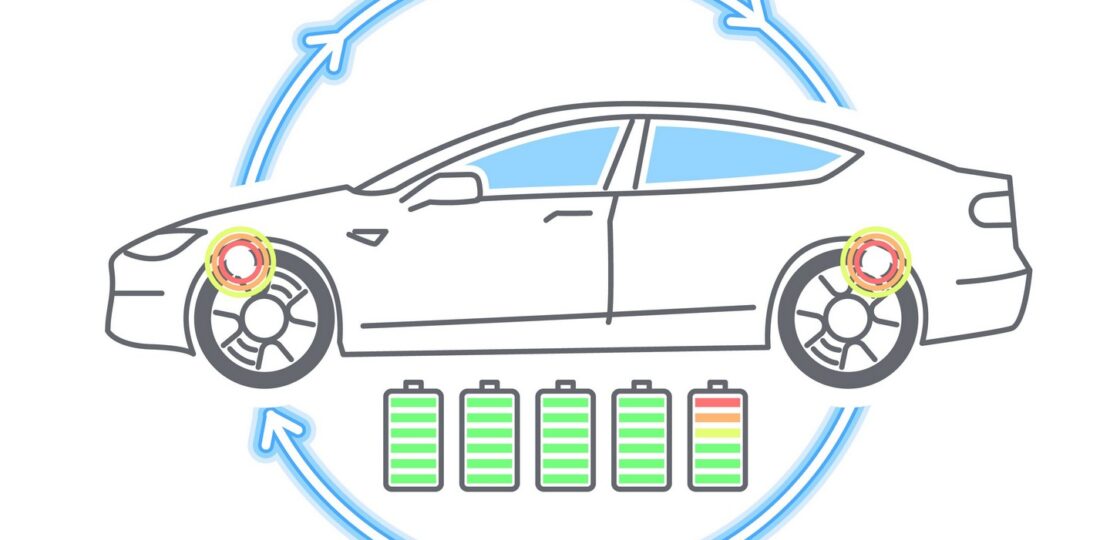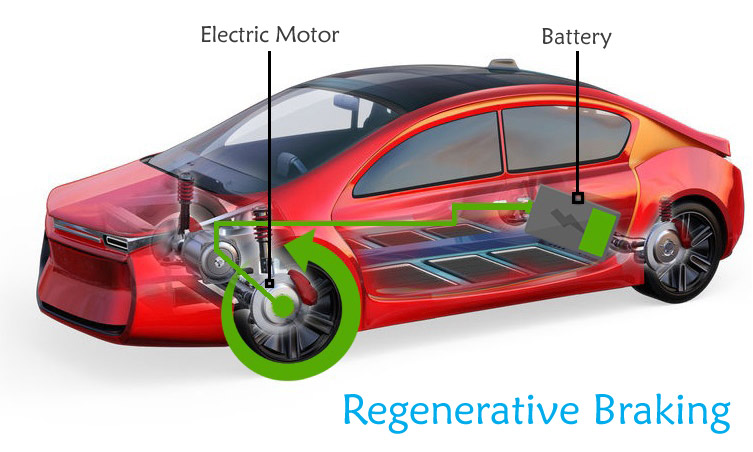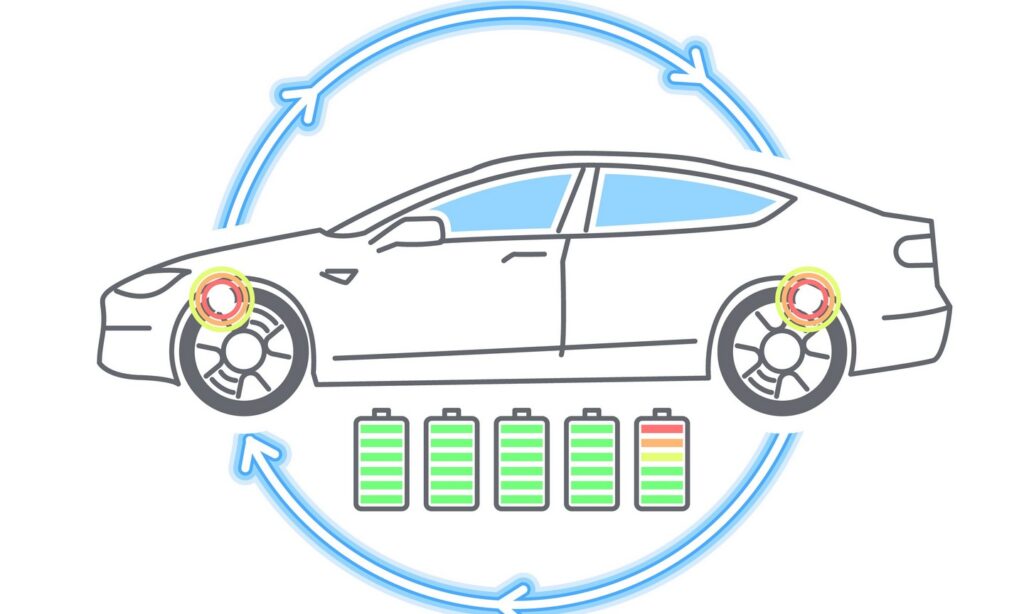
In the world of electric vehicles, regenerative braking plays a crucial role in enhancing their efficiency and sustainability. By harnessing the energy that is typically wasted during traditional friction braking, regenerative braking allows electric vehicles to recharge their batteries and extend their range. This innovative technology not only reduces wear and tear on the vehicle’s braking system, but it also contributes to a greener future by minimizing energy waste. In this article, we will explore the fascinating concept of regenerative braking and its impact on the world of electric vehicles. So, fasten your seatbelts and let’s dive into the captivating world of regenerative braking!
Introduction
Defining regenerative braking
Regenerative braking is a cutting-edge technology that plays a vital role in the operation of electric vehicles (EVs). It refers to the process of utilizing the electric motor in an EV to convert kinetic energy into electrical energy during deceleration or braking. Unlike traditional friction braking systems that dissipate energy in the form of heat, regenerative braking captures this otherwise wasted energy and stores it in the vehicle’s battery for later use. This innovative braking system not only improves the energy efficiency of EVs but also offers numerous other advantages that make it an essential component in the world of electric transportation.
Importance of regenerative braking in electric vehicles
Regenerative braking is a crucial feature in electric vehicles due to its ability to contribute to the overall efficiency and performance of these eco-friendly automobiles. As the world faces the pressing issue of reducing carbon emissions and combatting climate change, the adoption of electric vehicles has gained significant momentum. However, for EVs to become a viable alternative to conventional gasoline-powered vehicles, it is essential to maximize their range, energy efficiency, and sustainability. Regenerative braking plays a pivotal role in achieving these goals by offering enhanced energy recovery, extended range, reduced brake wear, and the capture and reuse of wasted energy. Understanding how regenerative braking works and its benefits is key to appreciating its significance in the realm of electric vehicles.
How does regenerative braking work?
Explanation of the concept
Regenerative braking operates on the principle of electromechanical energy conversion. When an electric vehicle decelerates or applies the brakes, the electric motor transitions from being a motor to functioning as a generator. In this mode, the rotation of the wheels drives the motor, and the motor generates electricity, which is then directed to the battery for storage. By reversing the flow of electrical current, regenerative braking converts the kinetic energy of the moving vehicle into electrical energy. This energy can later be used to power the vehicle, reducing reliance on external charging and enhancing overall energy efficiency.
The role of the electric motor
The electric motor is at the heart of regenerative braking, playing a central role in the conversion of kinetic energy into electrical energy. In an electric vehicle, the electric motor serves as both the propulsion system and the generator during regenerative braking. When the driver releases the accelerator or applies the brakes, the electric motor switches from consuming electrical energy to regenerating it. The motor is designed to harness the rotational energy produced by the wheels and convert it into electrical energy, which is then used to recharge the vehicle’s battery. This seamless transition between propulsion and energy recovery is a key factor that distinguishes regenerative braking from conventional friction-based brake systems.
Conversion of kinetic energy to electrical energy
During regenerative braking, the kinetic energy of the moving vehicle is harnessed and transformed into electrical energy, which can be stored and utilized later. This process involves several components working in harmony to achieve energy conversion. As the driver applies the brakes, a small computer called the regenerative braking control unit receives signals and commands from various sensors and manages the conversion process. The control unit regulates the activation of the electric motor as a generator and determines the optimum amount of kinetic energy to be converted. The electrical energy generated is then directed to the battery, where it is stored and made available for future use. This efficient energy recovery mechanism reduces the reliance on external charging and contributes to the sustainability and prolonged range of electric vehicles.

Benefits of regenerative braking
Enhanced energy efficiency
One of the significant benefits of regenerative braking is its ability to improve the overall energy efficiency of electric vehicles. By converting kinetic energy into electrical energy during deceleration or braking, regenerative braking allows for the recovery and reuse of energy that would otherwise be dissipated as heat in traditional friction-based braking systems. This energy recovery process significantly reduces the energy required to propel the vehicle, thereby improving its overall efficiency and reducing the reliance on external charging sources. With enhanced energy efficiency, electric vehicles can cover longer distances on a single charge, making them more practical and convenient for everyday use.
Extended range
The implementation of regenerative braking in electric vehicles also offers the advantage of an extended range. By capturing and storing otherwise wasted energy, regenerative braking contributes to a more efficient utilization of the vehicle’s battery capacity. As a result, the range of electric vehicles can be significantly increased, overcoming one of the main limitations of early EV models. Longer range capabilities make EVs more competitive with traditional gasoline-powered vehicles, providing users with the confidence to embark on longer journeys without the fear of running out of power. The extended range offered by regenerative braking is a key factor in accelerating the adoption of electric vehicles as a viable alternative to fossil fuel-driven transportation.
Reduced brake wear and tear
In conventional friction braking systems, excessive wear and tear of brake pads and rotors are common occurrences due to the heat generated during braking. However, regenerative braking drastically reduces the reliance on friction brakes, resulting in a significant decrease in brake wear. As the electric motor in an EV takes on the role of the primary braking mechanism, the friction brakes are utilized less frequently. This reduced usage translates to decreased wear and tear on the brake components, leading to lower maintenance costs and prolonging the lifespan of the brake system. By minimizing brake wear, regenerative braking not only enhances the overall performance and reliability of electric vehicles but also provides cost savings for EV owners.
Capture and reuse of wasted energy
One of the most compelling benefits of regenerative braking is its ability to capture and reuse otherwise wasted energy. In traditional vehicles, the energy dissipated during braking is lost in the form of heat, resulting in inefficiency and energy waste. Regenerative braking revolutionizes this process by converting the kinetic energy of the moving vehicle into electrical energy, which is then stored and made available for later use. By capturing and reusing this wasted energy, regenerative braking maximizes the efficiency of EVs and contributes to a more sustainable and eco-friendly mode of transportation. The ability to recover and reuse energy sets regenerative braking apart as a key component in the global shift toward cleaner and greener mobility solutions.
Challenges for regenerative braking in EVs
Limited efficiency at high speeds
Although regenerative braking offers numerous benefits, it does face a few challenges that need to be addressed for optimal performance. One such challenge is the limited efficiency of regenerative braking systems at high speeds. As the vehicle travels at higher speeds, the amount of kinetic energy generated during deceleration or braking increases. However, the regenerative braking system has limited capacity to absorb and store large amounts of energy within a short period. This limitation can result in reduced energy recovery efficiency at high speeds, compromising the overall performance and range of an electric vehicle. Overcoming this challenge requires advancements in regenerative braking technology and improvements in energy storage capabilities.
Effectiveness in cold weather conditions
Another challenge for regenerative braking in EVs is its effectiveness in cold weather conditions. Lower temperatures can impact the efficiency of the regenerative braking system, reducing the amount of energy that can be recovered. Cold weather can cause a decrease in battery performance and capacity, which in turn affects the overall energy recovery process. To tackle this challenge, manufacturers are working on developing battery systems that can maintain optimal performance in extreme temperatures. Additionally, advancements in heating systems for batteries and regenerative braking components can help mitigate the negative effects of cold weather on energy recovery efficiency.
Integration with traditional friction brakes
Integrating regenerative braking with traditional friction brake systems is another challenge that manufacturers face in the development of electric vehicles. It is crucial to strike the right balance between regenerative braking and traditional braking to ensure optimal performance and safety. In emergency situations or when additional braking power is required, friction brakes are necessary to provide instantaneous stopping power. Achieving seamless integration between the two braking systems poses technological and engineering challenges that need to be carefully addressed. Manufacturers are investing in research and development to optimize the coordination between regenerative braking and friction braking, ensuring smooth and reliable braking performance in all driving conditions.

Implementations of regenerative braking in EVs
Different regenerative braking systems
Regenerative braking can be implemented in different ways, depending on the specific design and architecture of the electric vehicle. The two primary types of regenerative braking systems commonly used in EVs are electric motor braking and hydraulic regenerative braking.
In electric motor braking, the motor functions as a generator during deceleration or braking, converting the kinetic energy of the moving vehicle into electrical energy. This electrical energy is then directed back to the battery for storage, contributing to the overall energy efficiency and range of the EV.
Hydraulic regenerative braking, on the other hand, utilizes hydraulic fluid and pumps to capture and store energy during braking. This system is often used in hybrid electric vehicles (HEVs) and uses hydraulic accumulators to store energy for later use.
The implementation of regenerative braking systems varies across different electric vehicle models, with each manufacturer adopting a design that best suits their specific engineering requirements and performance goals.
Examples of EV models with regenerative braking
Regenerative braking has become a common feature in many electric vehicle models available in the market today. The technology is used by renowned EV manufacturers such as Tesla, Nissan, BMW, and Chevrolet, among others.
Tesla, known for its innovative electric vehicle technologies, incorporates regenerative braking in its models like the Model S, Model 3, and Model X. These vehicles utilize regenerative braking to enhance energy efficiency and extend the range, contributing to the overall sustainability and performance of Tesla’s electric vehicle lineup.
Nissan, with its popular LEAF electric vehicle, also utilizes regenerative braking to capture and store energy during deceleration and braking. This feature has been instrumental in improving the range and efficiency of the LEAF, positioning it as one of the leading electric vehicles in the market.
BMW offers regenerative braking as a standard feature in its electric vehicle range, including models like the i3 and i8. By effectively harnessing and reusing the energy generated during braking, BMW’s electric vehicles deliver enhanced energy efficiency and an extended range.
Chevrolet, with its Chevrolet Bolt EV, has also incorporated regenerative braking to maximize the energy recovery and efficiency of the vehicle. This feature allows the Bolt EV to offer an impressive range on a single charge, making it a popular choice among electric vehicle enthusiasts.
These examples highlight the widespread implementation of regenerative braking in electric vehicle models, further underscoring its significance in the field of electric transportation.
Comparison with traditional braking systems
Differences in energy conversion
The key distinction between regenerative braking and traditional friction-based braking systems lies in the method of energy conversion. Regenerative braking converts the kinetic energy of the moving vehicle into electrical energy, which is then stored and reused. In contrast, traditional braking systems convert the kinetic energy into heat energy, dissipating it into the environment. This fundamental difference in energy conversion allows regenerative braking to offer significant advantages, including enhanced energy efficiency and extended range for electric vehicles.
Effectiveness for different driving conditions
Regenerative braking is highly effective in urban driving conditions, where frequent stops and deceleration occur. The continuous engagement of regenerative braking during these driving scenarios allows for optimal energy recovery and battery recharge, making it particularly well-suited for city driving. On the other hand, traditional friction-based braking systems excel in high-speed and emergency stopping situations where immediate braking power is crucial. The integration of both types of braking systems allows for a comprehensive approach to braking performance, ensuring safety and efficiency across a wide range of driving conditions.
Environmental impact
Regenerative braking offers significant environmental benefits compared to traditional braking systems. By converting kinetic energy into electrical energy, regenerative braking minimizes energy waste and reduces carbon emissions. In contrast, traditional braking systems release harmful pollutants into the environment in the form of heat and brake dust. The eco-friendly nature of regenerative braking aligns with the broader goal of reducing carbon emissions and transitioning to sustainable mobility solutions. The adoption of regenerative braking in electric vehicles contributes to the creation of a cleaner and greener transportation ecosystem, fostering a healthier environment for future generations.

Future advancements in regenerative braking
Improved energy recovery efficiency
Future advancements in regenerative braking technology will focus on improving the energy recovery efficiency of electric vehicles. Researchers and manufacturers are exploring ways to increase the amount of kinetic energy converted into electrical energy during deceleration and braking. This could involve advancements in motor and generator design, as well as improvements in energy storage systems. By maximizing energy recovery efficiency, electric vehicles can cover even longer distances on a single charge, making them more practical and competitive in the automotive market.
Integration with other energy storage systems
The integration of regenerative braking with other energy storage systems is another area of potential advancement. Researchers are exploring the possibility of utilizing supercapacitors, flywheel energy storage systems, and even battery systems specifically dedicated to energy recovery during regenerative braking. This integration would provide additional avenues for storing the captured energy and further enhance the performance and efficiency of electric vehicles. By leveraging multiple energy storage systems, the limitations of individual technologies can be overcome, opening up new possibilities for energy recovery and utilization in the realm of electric transportation.
Potential for autonomous braking systems
The future of regenerative braking holds exciting possibilities for the development of autonomous braking systems. By combining regenerative braking with advanced driver assistance technologies, such as radar, lidar, and artificial intelligence, autonomous braking systems can enhance vehicle safety and efficiency. These systems would be capable of detecting obstacles and applying the brakes automatically, utilizing regenerative braking to recover and store energy during emergency braking situations. The integration of regenerative braking with autonomous driving technologies can revolutionize vehicle safety and make electric vehicles even more reliable and trustworthy.
Conclusion
In conclusion, the role of regenerative braking in electric vehicles is undeniably significant. This innovative technology allows for the conversion of kinetic energy into electrical energy during deceleration and braking, contributing to enhanced energy efficiency, extended range, reduced brake wear, and the capture and reuse of wasted energy. Despite the challenges it faces, such as limited efficiency at high speeds and effectiveness in cold weather conditions, regenerative braking continues to evolve and improve. Its implementation in various electric vehicle models highlights its widespread adoption and effectiveness in contributing to the overall performance and sustainability of electric transportation. As advancements in regenerative braking technology continue to progress, the future outlook for electric vehicles with regenerative braking systems is promising, with improved energy recovery efficiency, integration with other energy storage systems, and the potential for autonomous braking systems. Regenerative braking remains at the forefront of the evolution of electric vehicles, shaping a cleaner, greener, and more efficient future for transportation.

RELATED POSTS
View all


